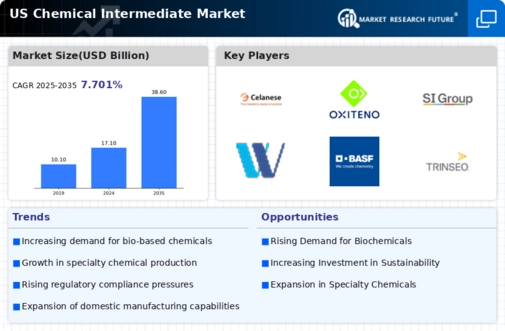The US Chemical Intermediate Market is characterized by its dynamic and evolving landscape, driven by various factors including technological advancements, regulatory changes, and shifts in consumer demand. Key players in the market are continuously working to innovate and optimize their production processes, which directly impacts their competitive positioning. The market exhibits a complex network of suppliers and manufacturers, all vying for a larger share of the consumer base. Companies are adapting to trends such as sustainability and digitalization, influencing their strategies and operations.
This marketplace is not only influenced by domestic factors but also by global supply chain dynamics, making it imperative for companies to remain agile and responsive to changes in market conditions.Celanese has established itself as a formidable player in the US Chemical Intermediate Market, recognized for its strong portfolio of specialty and industrial chemical products. The company's extensive presence in the region allows it to cater to a diverse range of industries, promoting sustainable solutions through its innovative offerings.
Celanese's strengths lie in its robust R&D capabilities, which enable the continuous development of high-performance materials tailored to meet specific industry needs. Its commitment to innovation, combined with strategic partnerships and collaborations, has solidified its competitive advantage in the market. Furthermore, Celanese's operational excellence and supply chain efficiencies contribute significantly to its market leadership, enhancing its ability to meet demand while maintaining profitability.Oxiteno plays a crucial role in the US Chemical Intermediate Market, focusing on the production of specialty chemicals and surfactants.
Renowned for its high-quality products, Oxiteno has garnered a significant market presence through its dedication to customer satisfaction and innovation. The company’s strengths include its well-established manufacturing facilities and a wide distribution network that ensures timely delivery and accessibility of its product offerings across different sectors. Moreover, Oxiteno has undertaken strategic mergers and acquisitions to enhance its capabilities and expand its market reach within the US.
Its key products and services, aimed at industries such as agriculture, oil and gas, and cosmetics, position the company as a leader in providing tailored chemical solutions to meet diverse customer requirements, further solidifying its competitive standing in the region.



















